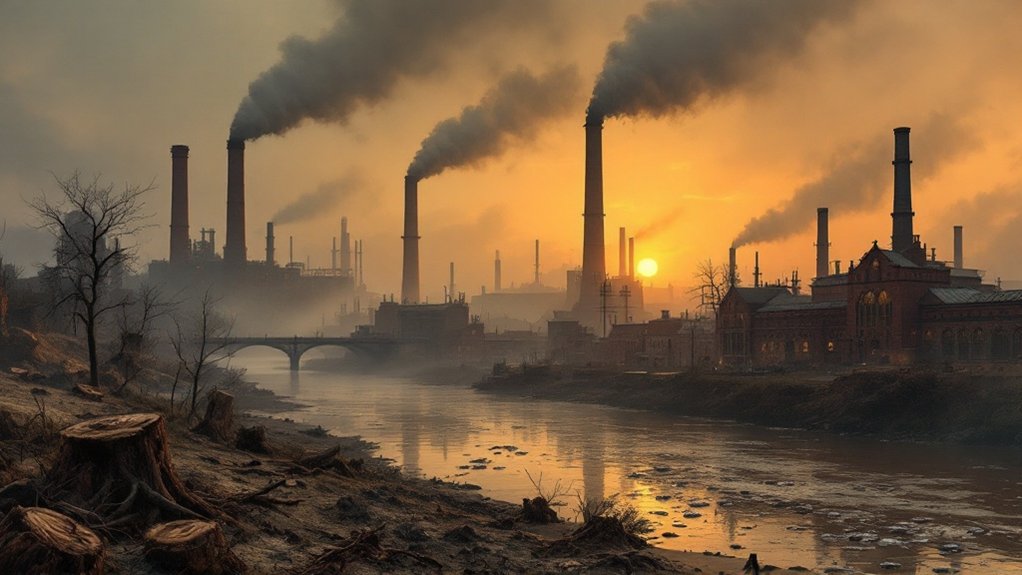The Industrial Revolution’s environmental toll was brutal and far-reaching. Cities choked on coal smoke while factories dumped toxic waste into rivers without a second thought. Massive deforestation wiped out ecosystems, and urban sprawl turned green spaces into concrete jungles. By 1950, CO2 levels had skyrocketed from 280 to 310 ppm, triggering climate changes. The Great Smog of 1952 killed 4,000 Londoners – just one chapter in this environmental nightmare that still shapes our world today.

While the Industrial Revolution brought unprecedented technological progress and economic growth, it also released environmental destruction on a scale humanity had never seen before. The air became thick with coal smoke, turning industrial cities into smog-filled nightmares. London and Manchester were barely recognizable under the haze. People coughed, wheezed, and developed respiratory illnesses. The Great Smog of 1952 caused 4,000 estimated deaths from severe respiratory issues. Meanwhile, acid rain ate away at buildings and killed vegetation. Not exactly the picture of progress they put in the history books.
Progress came at a devastating cost as coal-choked cities disappeared under toxic smog, leaving citizens gasping in industrial wastelands.
The water situation wasn’t any better. Industries treated rivers like their personal dumping grounds. Textile mills poured toxic dyes into waterways, mining operations contaminated groundwater with heavy metals, and sewage systems simply couldn’t cope. The result? Cholera outbreaks and dead fish. Lots of dead fish.
Trees didn’t fare well either. The desperate need for fuel wood and timber – for everything from shipbuilding to railway sleepers – led to massive deforestation. When the trees disappeared, so did countless animal species. The soil eroded, local climates changed, and rainfall patterns went haywire. But hey, at least they had plenty of railway sleepers.
Cities exploded in size, but not in a good way. Urban slums became breeding grounds for disease, green spaces vanished under a sea of brick and mortar, and the noise from factories never stopped. The proportion of people living in cities skyrocketed from just 17% in 1801 to an overwhelming 72% by 1891 in England and Wales. The urban heat island effect made everything worse – turns out replacing trees with concrete isn’t great for local temperatures.
Natural resources took a beating too. Coal miners dug deeper and deeper as easily accessible reserves ran dry. Coastal fish populations crashed from overfishing, and intensive farming practices degraded soil quality. The waste situation was equally grim – industrial processes created mountains of garbage with nowhere to go except landfills and water bodies. The extraction and burning of fossil fuels initiated an era of ocean acidification that continues to threaten marine ecosystems today.
Perhaps most ominously, greenhouse gas emissions from all this industrial activity pushed atmospheric CO2 levels from 280 ppm to over 310 ppm by 1950. Global temperatures began climbing, glaciers started melting faster, and extreme weather events became more common. The Industrial Revolution’s environmental bill would prove to be a steep one.








